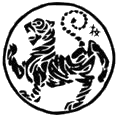History
Shotokan was founded in 1939 in Japan and is a style of karate, developed from various martial arts by Gichin Funakoshi (1868–1957) and his son Gigo (Yoshitaka) Funakoshi (1906–1945). Shoto was Funakoshi’s pen-name, which he used in his poetic and philosophical writings and messages to his students. The Japanese kan means “house” or “hall”. In honour of their sensei, Funakoshi’s students created a sign reading shōtō-kan which was placed above the entrance of the hall where Funakoshi taught.
and his son Gigo (Yoshitaka) Funakoshi (1906–1945). Shoto was Funakoshi’s pen-name, which he used in his poetic and philosophical writings and messages to his students. The Japanese kan means “house” or “hall”. In honour of their sensei, Funakoshi’s students created a sign reading shōtō-kan which was placed above the entrance of the hall where Funakoshi taught.
The principles of Shotokan allude to notions of humility, respect, compassion, patience, and both an inward and outward calmness. Funakoshi wrote: “The ultimate aim of Karate lies not in victory or defeat, but in the perfection of the character of the participant.
Shotokan training is usually divided into three parts: kihon (basics), kata (forms or patterns of moves), and kumite (sparring). Techniques in kihon and kata are characterized by deep, long stances that provide stability, enable powerful movements, and strengthen the legs. Shotokan is often regarded as a ‘hard’ and ‘external’ martial art because it is taught that way to beginners and coloured belts to develop strong basic techniques and stances. Initially strength and power are demonstrated instead of slower, more flowing motions.

